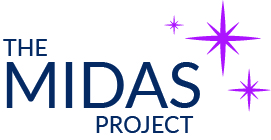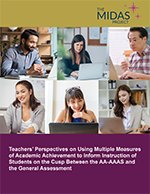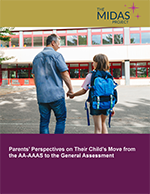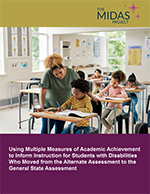Historically, some students were inappropriately identified to participate in the alternate assessment based on alternate academic achievement standards (AA-AAAS). States have worked diligently over the past several years to ensure that the right students are participating in the appropriate assessment. When students shift from the alternate assessment to the general assessment, educators sometimes do not know how to confidently provide them with the instruction and support they need.
The MIDAS project, affiliated with the National Center on Educational Outcomes (NCEO), aims to help state education agencies improve their support for schools and districts. It focuses on using multiple measures of academic achievement to enhance instruction for students with disabilities who move from alternate to general assessments. MIDAS conducted several research activities to learn more about these students.
Two of the studies sought to learn more about the successes and barriers that teachers face when educating students with disabilities who shift assessments. The findings of a classroom observations and interviews study are shared in a report titled, A Mixed Methods Study on Teaching Students Who Moved From the AA-AAAS to General State Assessment. The findings of several online focus groups are presented in Teachers’ Perspectives on Using Multiple Measures of Academic Achievement to Inform Instruction of Students on the Cusp Between the AA-AAAS and the General Assessment.
Interviews were also conducted with parents of students who shifted assessments. The findings were published in a report titled, Parents’ Perspectives on Their Child’s Move from the Alternate Assessment to the General Assessment. The study found that many parents know very little about the assessments their child takes, and were generally frustrated with their experiences dealing with schools. The report concluded with several strategies states and districts can use to help improve practice in how they involve parents of children with disabilities, especially parents of children on the cusp between the alternate and general assessment.
Additionally, MIDAS published a report on Using Multiple Measures of Academic Achievement to Inform Instruction for Students with Disabilities Who Moved from the Alternate Assessment to the General State Assessment. This report gives an overview of interim assessments and formative assessment practices that can inform instructional decision making for students with disabilities who moved from the alternate to the general assessment.





